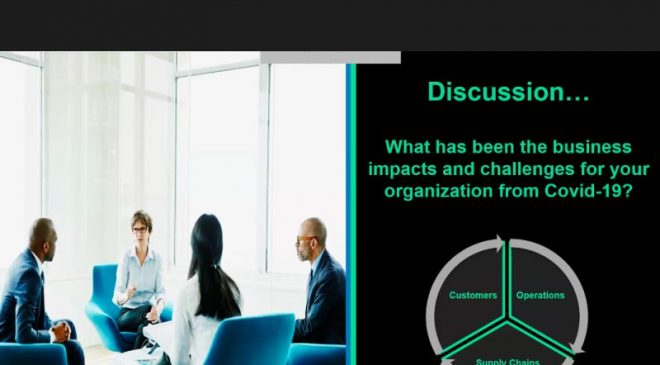
CenturyLink is now Lumen Technologies
Sponsored content: Wednesday, 2nd September 2020 – Singapore
Focus Network, in partnership with Lumen, brought together leading Singapore-based IT executives from both local and international enterprises to discuss important Industry topics, including:
The impact of COVID-19 on their businesses, and the new Future of Work to rebound from the effects of COVID-19
- Strategies being considered or currently implemented to enable their companies’ transformation agendas
- Best practices for rapidly delivering and running applications and workloads to maximize business responsiveness
The session was coordinated by Tyron McGurgan from Focus Network and providing great insights to the discussions were experienced strategy and thought leaders
Chris Levanes, Director of Solutions Marketing and BizOps, Lumen who is a veteran of the ICT industry with 20+ years of experience and has held numerous regional executive roles with Industry leaders – Red Hat, Microsoft and Hewlett Packard.
Chris Rezentes, Director, Product Management (Network), Asia Pacific, Lumen who leads the regional product strategy, P&L, and roadmap for Lumen’s entire network portfolio, and has extensive experience overseeing the strategy and expansion of fiber networks across APAC.
Reflecting upon the last 8 months
Levanes began the roundtable by reflecting upon the significant disruption that has occurred across the macro landscape. “A little over 8 months ago, most of you were probably focused upon Digital Transformation (DX), as was evident by data from the IDC FutureScapes survey of global CEOs. Which meant that to some degree or another, either you, your department or your organisation was likely looking to invest or continue upon DX initiatives in 2020, to ensure you remained competitive in the new digital future landscape. However, with the advent of the COVID-19 pandemic, it can be overstated how pervasive the impact has had upon our social structure on a daily basis.”
Levanes continued, “At the same time, the business impact to COVID -19 has been just as severe. Entire countries and economies have been subjected to government mandated shutdowns, resulting in new workplace health and safety regulations, restrictions on travel and business interactions, and so forth. While every organisation and industry vertical are different, generally the impact can be characterised across the 3 common areas: 1) How you engage and interact with your Customers, 2) How you leverage and do business with your Supply Chains and 3) How you maintain your Operations to keep the business running and the lights on.”
The roundtable delegates then shared some of their experiences of how their organisation have been impacted in these 3 areas:
“From a manufacturing industry perspective, what we missed most is the interactions and face to face meetings with our customer”, notes David Tay, Chief Information Officer, Beyonics International. “One of the most important aspects of our business development is when customers visit our facility and we are able to show the skillsets we possess, the technologically advanced machinery we use to produce components for them and are also able to show them samples of past products and projects, and therefore impress them with our capabilities. But with COVID-19, we are unable to invite customers to the site, especially when the majority of our customers are internationally spread outside of Singapore”.
Yan Zhang, Vice President IT, ST Engineering stated that “the impact [for her organisation] was mostly with their supply chain, as materials from overseas were impacted, which then impacted their customers. To minimise disruptions, the procurement team engaged in lots of follow-up virtual meetings with their supplier networks. Initially there were challenges with VPN and staff getting used to working virtually, but those have now been ironed out and they are settling into a good momentum with the new ways of working remotely.”
The Financial Services Industry is a highly regulated sector where adherence to regulation and governance of business continuity, security and privacy are critical. However, for some organisations, business continuity planning was not sufficiently setup for the challenges they encountered from the pandemic, and those BCP had to be quickly expanded to address the unique circumstances. One delegate shared insight on how his FSI organisation overcame their challenges… “We look at Asia and the emerging markets as a significant growth catalyst for the business globally”, says Chris Bezuidenhout, Chief Information Officer, Deutsche Bank, “and a large proportion of our growth targets for the year were centred around our ability to expand the client base and increase trading volume in emerging markets in Asia. Most of these interactions work when orchestrated face-to-face, as they work on a trust basis; however our sales teams have been completely dislocated by the environment that we found ourselves in over the course of the last 9 months.” Bezuidenhout continued, “This prompted them to invent ways and solutions to bridge that gap. To rely on the cold interactions on a zoom call or just a call itself is much harder to achieve and to build trust. Especially when interacting with corporate clients, and when trying to sell services to them. That was by far the biggest challenge that their organisation faced. There are certain procedures and policies enforced to prevent data leak and [data] being transmitted externally. And that also makes it difficult for teams to interact in the way that one would expect. Hence, they resorted to innovation and made changes to integrate apps like WhatsApp and WeChat into some of their localised chat solutions, where they had security protocols enacted. So, it has definitely been a challenge to tech organisations to cater [for] solutions for the business to succeed at this point of time.”
“The infodemic is growing faster than COVID-19”, says Soon Tien Lim, Vice President IT, ST Electronics, “Most of our concerns with our employees working from home was the management of the ‘infodemic’ versus the real world and this was seen during SARS outbreak as well. Cyber-phishing and cyber security have been the big concerns in this new landscape.”
Rezentes also shared the experiences of Lumen. He indicated that “Lumen had received many requests from customers to help them with their immediate requirements of quickly enabling a remote workforce to ensure operational continuity.” Rezentes elaborated that “for a number of our customers, these conversations centred around redesign of the network to better support the connectivity and performance of a much higher than anticipated remote workforce.”
The future of connectivity
Looking at the future of connectivity, Levanes stated that, “Pre-COVID, the Network had become a foundational platform for transformational technologies. Post-COVID, Network Connectivity is even more vital to successfully rebounding to the ‘new normal’ of work.”
Rezentes elaborated upon this area by saying, “For many organisations who have successfully implemented Work From Home (WFH) strategies, a good portion are stating that it is unlikely they will look to fully bring back their workforce until sometime next year. Moreover, having already invested in technologies and processes to maintain their business operations throughout the pandemic lockdowns, many organisations are realising they can reduce costs by having a portion of their workforce remain working from home permanently. Some early market estimates indicate that many end up being as high as 30%. Hence the focus for many organisations is now upon how to securely and effectively optimise their network connectivity to accommodate the requirements of the post-COVID landscape.”
“We are all-in on the cloud for everything we use”, mentioned Steve Ng, VP, Digital Platform Operations, MediaCorp Pte Ltd. “As part of our digital transformation journey we are trying to engage more with customers and [are] focussing on how to increase traffic to our sites and apps to make the user experience better and incorporate measurements to understand our audience. With COVID-19, everything is now going to digital, people work from home and the content has to be more general across a wider audience. In the past, peak time [for us] was either during early morning commute hours, lunch time and after office hours, which is when people are off-work and starting to consume the content on our properties. But now it is a flat line from 7AM to midnight, as people are consuming content all the time.”
“We did an 18-month migration project to migrate our on-prem ERP to a cloud-based ERP,” shared David Tay, Chief Information Officer, Beyonics International. “Having heard the other delegates talk about the challenges of COVID-19 and work from home scenarios where there have been issues accessing the VPN, we were quite fortunate that we had already migrated the 4 countries operations to cloud from January this year.” David continued, “…so it was less of an issue when we had to work from home, as lot of our core applications like email, messages, conferencing, ERP are all out there in the cloud already. The challenges we had, which we shared with the management, was the fact that when working from the office, we only needed to secure ‘two doors’, but now with around 300 employees working from home using the corporate network, there are potentially 300 ‘open doors’ where viruses can creep in. And this has been our biggest challenge in recent times.”
SD-WAN deployment strategy considerations
Rezentes emphasized that, “SD-WAN has emerged as a significant architectural response to the need for increased WAN efficiencies in organizations and for optimizing the end-user experience across a plethora of public and private cloud applications.”
Maita Cabinian, APAC Regional IT Director, PZ Cussons Singapore Pte Ltd. shared her experiences, “One of our biggest challenges was that we signed up a contract with a 3rd party provider to revamp our network and we were supposed to go full scale implementation by start of this year transitioning our global network to the new provider. But we got into the pandemic and all travel were stopped and so did the deployment. In the meantime the business changed quite a lot , we closed several of our depots and we worked more virtually with our customers, supply chain partners and the whole organisation moved to a digital working so that changed the previous assumptions we had for our network transformation which were no longer applicable. So, we had to pivot and change our strategy and come up with a combination of traditional MPLS and SD-WAN setup. For the big sites where we needed to ensure connectivity was at its most reliable, we continued with the MPLS journey there and for the other smaller sites were implemented with SD-WAN. “
“Our consideration is to adopt more XaaS as it is already built in with the application security for the internet but we also are trying to make sure that at the user side, we deploy EDR (Endpoint Detection Response) basically monitoring the device; and obviously all this requires investment and one of the things we need to balance this with is the network costs with SD-WAN and needs a restructure”, explained Justin Ong, IT General Manager, Panasonic.
Further into the roundtable, there was a deep discussion on the transport layer, and it was agreed that the flexibility that SD-WAN brings to the table allows organisations to access their important and critical applications across a secure VPN network, and then also take advantage of an IP Network for their other application usages.
Another key topic of discussion that occurred was whether to inhouse or outsource any network transformation or SD-WAN adoption initiative. Rezentes indicated that this is often a commonly recurring consideration for many organisations, and shared “often many organisations look at outsourcing providers as a way to focus upon what’s right for their business, and hence, leave the implementation of SD-WAN and management of the network infrastructure to a managed service providers. Furthermore, we frequently find that when customers are engaging a service provider for their transformational connectivity, they are also likely to be seeking assistance to secure their environments.”
Evolving to the ‘New Normal’
Levanes wrapped up the session by saying, “The pandemic has underscored the importance of digital transformation in the eyes of many CxOs. They now find themselves at a decision point – to follow the same course of cost cutting as previous recessions have dictated – or to flatten their own organization’s recessionary curve by leveraging technology, in which to transform and quickly rebound to the next New Normal.”
He continued, “To underpin the return to growth and strive to modernise their processes and value chains, we find that they are seeking to engage strategic technology partners that are going to help them evolve their business to the future digital landscape. Lumen has a longstanding history of serving some of the top companies in the world, and has established a strong position to support organisations on their connectivity and transformation journeys.”
This brought to conclusion the interactive session with participation from the delegates and great discussions facilitated by Lumen. Focus Network facilitates a data-driven information hub for senior-level executives to leverage their learnings from, while at the same time assisting businesses in connecting with the most relevant partners to frame new relationships. With a cohort of knowledge hungry and growth minded delegates, these sessions have seen imparting great value for participants. With the advent of the new ways of working remotely, Focus Network continues to collaborate with the best thought leaders from the industry to still come together to share and navigate the ever-changing landscapes that’s barrelling into the neo industrial revolution.
About Lumen
Lumen is guided by our belief that humanity is at its best when technology advances the way we live and work. With 450,000 route fiber miles serving customers in more than 110 countries, we deliver the fastest, most secure global platform for applications and data to help businesses, government and communities deliver amazing experiences.
Tags: Business AgilityCenturyLinkCloud ServicesCOVID-19lumenremote working




